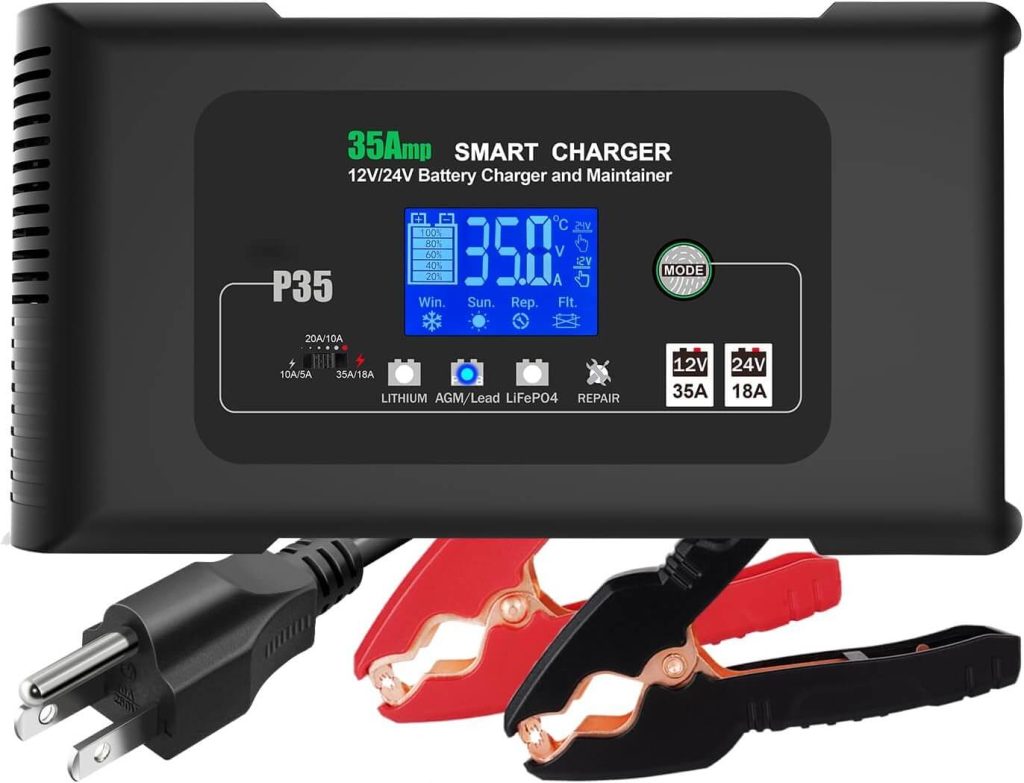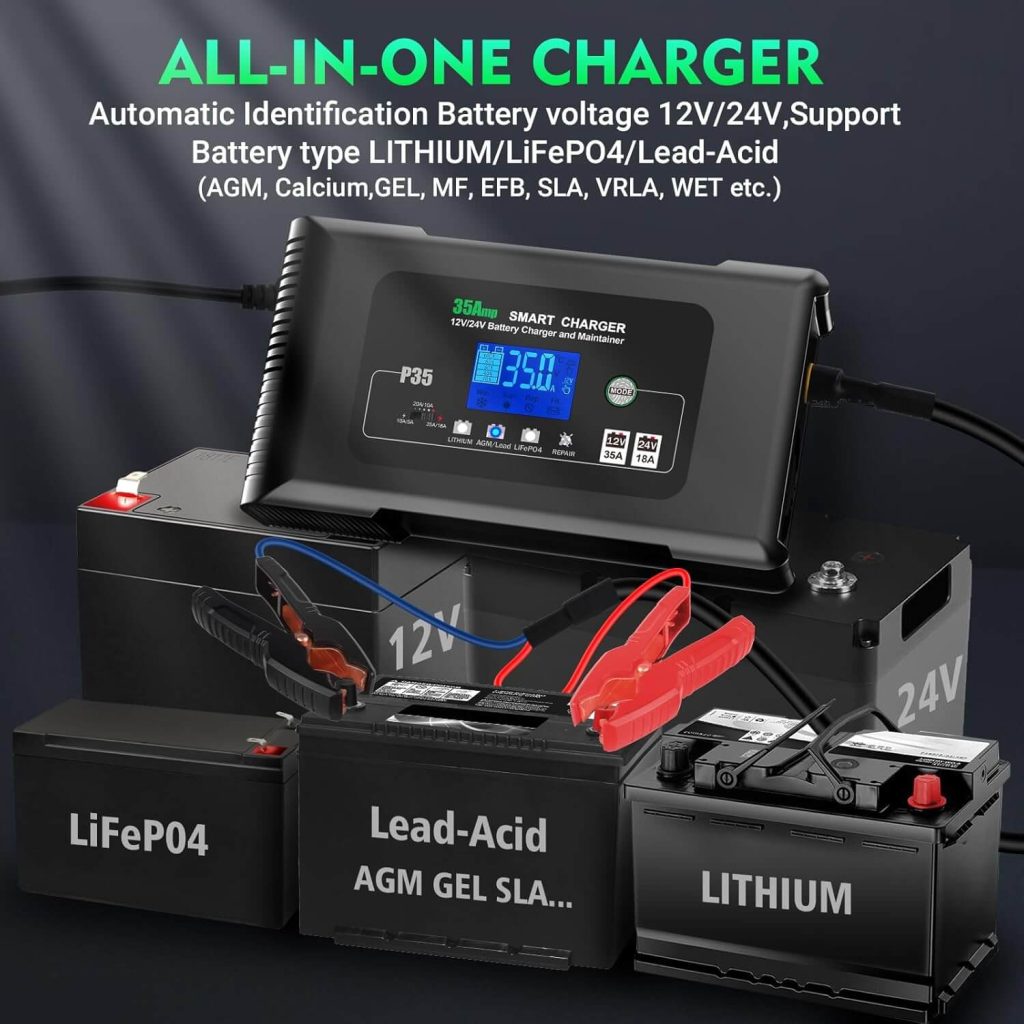If you’ve ever dealt with a dead car battery in the middle of nowhere or tried to revive an aging deep-cycle battery for your RV, you already know how frustrating unreliable chargers can be. That’s where the HTRC P35 starts to stand out. But what actually makes it different from other so-called “smart” chargers out there?
Can one charger really handle everything from lithium to lead-acid, from boats to motorcycles? And what about battery safety—can it charge quickly without overcooking your cells?
These are the kinds of real-world questions that matter when choosing a charger for your workshop, garage, or vehicle fleet. In this blog, we’ll take a closer look at a charger that promises to handle 12V and 24V systems, work with LiFePO4 and AGM batteries, and even repair mildly damaged batteries using pulse technology—all while fitting neatly into your travel kit or garage shelf.
Is it really as versatile and reliable as it sounds? Let’s see what the details reveal.
A Closer Look at the HTRC P35 Smart Charger
Before buying any battery charger, it’s important to know what you’re working with. The HTRC P35 isn’t your typical trickle charger. It combines high-output charging with smart controls, aiming to deliver both speed and safety. Whether you’re a mechanic, RV owner, or just someone tired of unreliable battery gear, this review will help you decide if it suits your needs.
Specifications
| Feature | Detail |
|---|---|
| Charging Voltage | 12V / 24V (auto-detect) |
| Max Output Current | 35 Amps at 12V / 18 Amps at 24V |
| Supported Batteries | LiFePO4, Lithium, AGM, GEL, SLA |
| Repair Mode | Pulse repair for lead-acid batteries |
| Display | LCD screen with charging info |
| Size (L x W x H) | 9″ x 10.98″ x 3.42″ |
| Shell Material | ABS fire-retardant housing |
| Protection Features | Overvoltage, reverse polarity, temp |
Real-Use Review: How Does the HTRC P35 Perform?
Right out of the box, the HTRC P35 feels sturdy, not overly bulky, but made for serious jobs. It’s got a clean interface and a large LCD screen, which displays voltage, charging amps, battery percentage, mode selection (summer/winter), and even internal temperature. This kind of visual feedback is especially helpful when you’re charging expensive lithium or deep-cycle batteries and want a sense of what’s going on.
Versatility is its strong point. During testing, it automatically recognized whether a 12V or 24V battery was connected. This is a big plus if you’re juggling different types of batteries—say, one for your truck and another for your solar backup system. You don’t need to adjust the voltage manually; it does that on its own.
It also has a one-touch repair mode. I tried this on an old AGM battery that was starting to fade. After a couple of cycles in repair mode, it didn’t magically restore the battery to brand new, but I did see improved voltage stability, and it held charge longer. That’s about as much as you can reasonably expect from pulse repair technology—it works, but only to a point.
One underrated feature is how quiet and cool this charger runs. Even after hours of charging a 200Ah lithium bank, it didn’t overheat or throw off loud fan noise. That says a lot about its internal safety and design.
On the downside, if you’re working with very small batteries—like 6Ah–15Ah motorcycle batteries—this might be overkill. The current is high, even when adjusted, and using the repair function on smaller units could risk cell stress if you’re not careful. It’s better suited for mid-to-large capacity batteries.
Also worth noting: this is not a jump starter. It won’t bring a battery back from absolute zero. If your battery is below 2.0V, even the repair mode may not kick in.
- Wide compatibility with battery types (LiFePO₄, AGM, SLA)
- Fast charging with automatic voltage detection
- Easy-to-read LCD display with detailed charge info
- One-button repair mode for mild desulfation
- Flame-resistant, durable shell
- Works well in both hot and cold environments
- Not ideal for very small batteries
- Repair mode won’t fix severely damaged batteries
- No jump-start function
If your garage has a mix of lithium and lead-acid batteries, and you need one charger that can do it all—quickly and safely—the HTRC P35 has the features and performance to justify its place on your shelf.
How to Choose the Right Smart Battery Charger for Your Needs
With so many battery chargers on the market, choosing the right one can get confusing. Not every charger is built the same—and not every battery has the same needs. In this blog, we’ll walk through a few key things to consider before purchasing a smart charger like the HTRC P35.
What to Look for in a Battery Charger
1. Check Battery Compatibility First
Before anything else, confirm whether the charger supports the type of battery you use. The HTRC P35 is compatible with LiFePO4, Lithium-ion, AGM, GEL, SLA, and flooded lead-acid batteries, making it a great all-rounder. If your battery isn’t on that list, the charger may not perform safely or effectively.
2. Understand the Voltage Requirement
Your battery system will either be 12V or 24V. Some chargers only work with one or the other. The HTRC P35 automatically detects the voltage, which removes the guesswork—ideal for users with both types in their vehicles or garage.
3. Consider the Amp Rating
More amps mean faster charging. The 35A output on the HTRC P35 makes it suitable for large-capacity batteries like those in RVs, boats, and solar systems. But if you mostly deal with small batteries, something with lower amperage may be safer and more cost-effective.
4. Look for Smart Features That Add Safety
A charger should protect both your battery and itself. The HTRC P35 includes reverse polarity protection, temperature control, over-voltage shutoff, and non-sparking clamps. These features aren’t just for convenience—they help prevent real accidents.
5. Display Matters More Than You Think
A clear digital display can show voltage, amperage, charge percentage, and even seasonal charging modes. With the HTRC P35’s LCD screen, you’re never guessing. It helps you make smart charging decisions in real time.
6. Know the Limits of Pulse Repair
Pulse repair sounds great—but it’s not magic. It can help recover sulfated lead-acid batteries that still have some life left, but it won’t fix shorted or totally dead cells. Be realistic with what you expect from this feature.
7. Match the Charger to Your Use Case
Are you a mechanic needing to charge multiple battery types quickly? Do you own a fleet of vehicles or off-grid gear? Or are you a casual user just trying to keep an old battery alive? The HTRC P35 works well for heavy-duty and frequent use. If you’re just charging a lawn mower once every 6 months, it’s probably more than you need.
8. Evaluate Portability and Build Quality
Size and design may not seem important until you try to pack it in your RV or store it on a crowded workbench. The HTRC P35 strikes a good balance—compact but rugged enough to handle rough environments.
When you know what features really matter, it becomes easier to pick a charger that won’t let you down. The HTRC P35 covers most use cases for vehicle owners, DIYers, and RV enthusiasts who want smart, safe, and fast charging.
Final Thoughts on the HTRC P35
Choosing a reliable battery charger isn’t just about voltage and amps — it’s about convenience, safety, and versatility. The HTRC P35 brings together all these elements in a practical, well-built unit designed for everyday users and professionals alike.
It’s not just the wide battery compatibility or the fast 35A charging that makes it worth considering — it’s also the attention to detail: a user-friendly LCD screen, automatic voltage detection, seasonal charging modes, and built-in safety protections. Features like pulse repair and trickle maintenance may not perform miracles, but they offer real value in prolonging the life of decent batteries that are showing signs of wear.
Of course, it’s not the perfect choice for everyone. If you mainly charge small batteries or need a jump starter, this may not be the right fit. But for RV owners, marine users, or anyone managing a variety of battery types, it strikes a smart balance between power, safety, and ease of use.
Frequently Asked Questions (FAQs)
Q1: Can the HTRC P35 charge both lithium and lead-acid batteries?
Yes, it supports LiFePO4, standard lithium, AGM, GEL, and SLA batteries.
Q2: Does this charger work for 24V batteries?
Absolutely. It auto-detects and switches between 12V and 24V battery systems.
Q3: Will it repair a completely dead battery?
Not always. It can help revive weak or sulfated batteries, but not those with zero volts or internal shorts.
Q4: Is it suitable for motorcycles or small batteries?
It’s better suited for mid-to-large batteries. Use caution or a lower-output charger for very small batteries under ~15Ah.
Q5: Can I leave the battery connected overnight?
Yes. The charger automatically switches to maintenance mode once charging is complete, helping prevent overcharging.
Q6: Does it have any safety features?
Yes, it includes protections like reverse polarity, overcharge, overvoltage, and temperature monitoring.
Q7: Is this charger portable?
It’s compact for its output range and can easily fit into toolkits, RVs, or garages without taking up much space.
Q8: Can it jump-start a car?
No, it is not a jump starter. It is designed to charge and maintain batteries, not start engines.
By understanding your needs and how the HTRC P35 fits into your daily use, you can avoid frustration and extend the life of your batteries with confidence.
Let your charger do more than just charge — let it protect your investment.


Leave a Reply